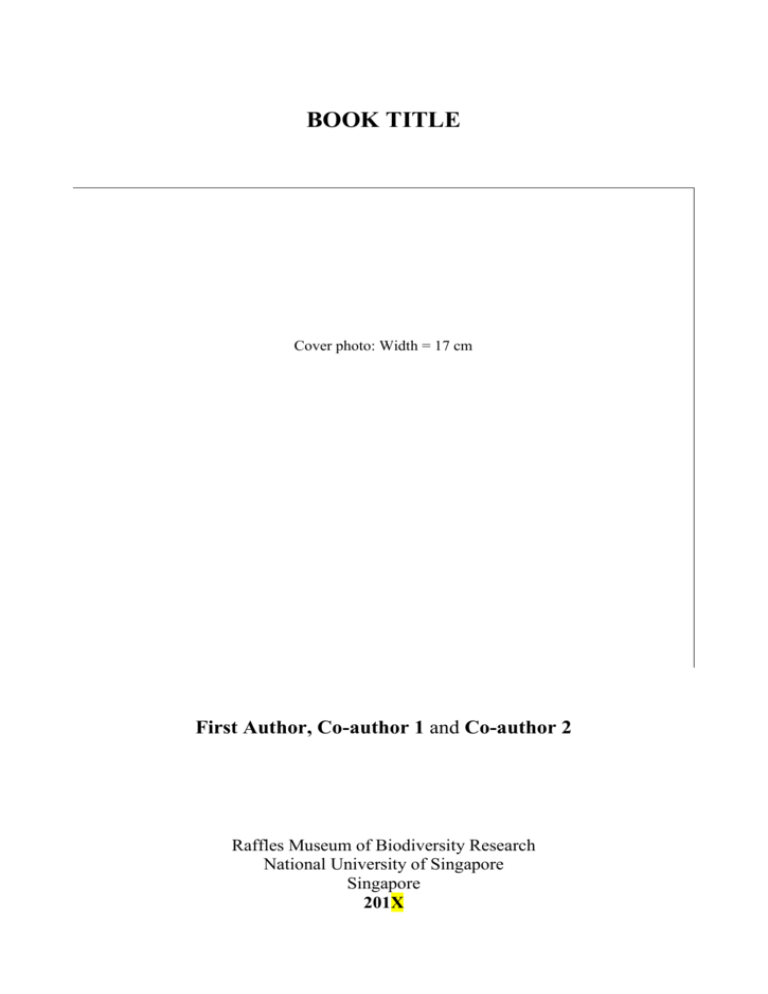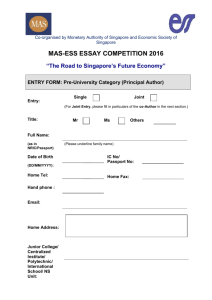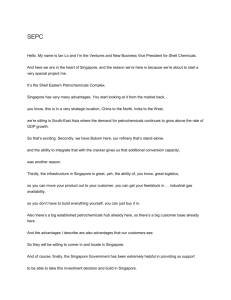
BOOK TITLE
Cover photo: Width = 17 cm
First Author, Co-author 1 and Co-author 2
Raffles Museum of Biodiversity Research
National University of Singapore
Singapore
201X
BOOK TITLE
First Author1, Co-author 12 and Co-author 23
1
Address of first author, Country
Address of co-author 1, Country
3
Address of co-author 2, Country
Email: <insert hyperlink> (initials of first author); <insert hyperlink> (initials of co-author 1);
and <insert hyperlink> (initials of co-author 2)
2
Raffles Museum of Biodiversity Research
National University of Singapore
Singapore
201X
Book Title by
First Author, Co-author 1 and Co-author 2
is published by the:
Raffles Museum of Biodiversity Research
Department of Biological Sciences
Faculty of Science
National University of Singapore
6 Science Drive 2
Singapore 117546
REPUBLIC OF SINGAPORE
Website: http://rmbr.nus.edu.sg/
Email: ask.rmbr@gmail.com
Editor:
XXX
Copy Editor: XXX
Typesetter: XXX
Cover photograph of XXXX © <Photographer’s name>
ISBN XXXX (online)
© 201X Raffles Museum of Biodiversity Research
All rights reserved. No part of this publication may be reproduced, stored in a retrieval system, or transmitted, in any
form, or by any means, electronic, mechanical, photocopying, recording or otherwise, without the prior permission of
the copyright holder. For information regarding permission(s), please write to: ask.rmbr@gmail.com
CONTENTS
1.
2.
3.
4.
5.
6.
7.
8.
Introduction ................................................................................................................................ 1
Raffles Museum Books Style Guide .......................................................................................... 1
a.
Taxonomy and Nomenclature ........................................................................................... 2
b.
Numbers and Units ............................................................................................................ 2
Tables and Figures ...................................................................................................................... 2
Referencing Style ....................................................................................................................... 3
a.
In-text Citation .................................................................................................................. 3
b.
How to Cite References .................................................................................................... 3
Literature Cited ........................................................................................................................... 4
Acknowledgements .................................................................................................................... 6
How to Cite this Book ................................................................................................................ 6
Index ........................................................................................................................................... 6
INTRODUCTION
To expedite publication, authors are advised to adhere to the preferred formatting style of the
Raffles Museum Books described in the following sections. Please ensure that any adopted format
is standardised in the entire manuscript. For the cover page and the front pages, fill in the
information in the format shown. For the content page, please follow the 10-mm hanging
indentation format given in the above example. Subheadings are not included in the content page,
but are done so here to show how chapter sections, where applicable, should be included in the
content page with a left indent and a hanging indent of 10 mm each. All books should begin with an
Introduction, and end with Literature Cited, Acknowledgements, and How to Cite this Book. Index
and appendices are optional, and should be at the end of the manuscript if applicable.
For books that are a compilation of chapters of written works by various authors, begin each chapter
on a fresh page with the chapter title followed by the authors’ information in the format given
below:
A. B. C. Dee1*, X. Y. Zed2 and Abdullah bin Abdul Aziz2
Department of Biological Sciences, National University of Singapore
14 Science Drive 4, Singapore 117543, Republic of Singapore
2
Raffles Museum of Biodiversity Research, National University of Singapore
6 Science Drive 2, Singapore 117546, Republic of Singapore
(*Corresponding author: dbsabcdee@nus.edu.sg)
1
RAFFLES MUSEUM BOOKS STYLE GUIDE
The general guidelines for the house style are as follows:
–
The page size should be A4 (210 mm × 297 mm) in portrait orientation with margins of 20
mm on all four sides.
–
Text is in Times New Roman font, size 12 point, single-spaced throughout, and justified.
–
Paragraphs should not be indented, and should be separated by a single-line space.
–
Contents of the book should be presented in sections (and subsections, if necessary) which
will be listed in the contents section of the book in the format given above.
–
When the book is long, divide the book into chapters and begin each chapter on a fresh page.
–
British and not American spelling should be used.
–
Numbered lists should have an indent of 10 mm.
–
Subheadings, where applicable, should begin paragraphs (as exemplified below).
1
First Author 1, Co-author 1 & Co-author 2
Taxonomy and nomenclature. — All scientific names must be used in accordance with the 4th
edition of the International Code of Zoological Nomenclature (1999) which came into effect on 1
Jan.2000 (for zoological names), and the 8th edition of the International Code of Botanical
Nomenclature (i.e., the Vienna Code, 2006) (for botanical names: names of algae, fungi, and
plants). Although authorship is not part of the scientific names and is stated as optional by the
Codes, it is recommended that the author(s) of each taxon are cited at its first mention. Care should
be taken when citing other references together with an authorship citation. There should be a clear
indication that the cited reference is not a taxonomic authority, either by modification of the
citation, e.g., “the intraspecific variation of Lutra lutra (see Harris, 1968)”; or by rearrangement of
the text “the intraspecific variation of Lutra lutra in Asia (Harris, 1968)”. Do not abbreviate
scientific names in the whole article, that is, do not put N. rafflesiana, but use Nepenthes rafflesiana
throughout.
Common names of organisms should be written in lower case throughout, except for parts which
are proper nouns or which originated from such, and should therefore be capitalised accordingly,
e.g., “common acacia”, “ikan haruan”, “Asian koel”, “Raffles’ pitcher plant”.
Numbers and units. — All numbers less than 10 should be spelt in full, unless in a measurement, a
designator, or in a range (e.g., five species, 4 min, day 2, 2–3 days). A range of values are to be
indicated with an en dash (–) and not a hyphen (-), e.g., pp. 1–21, 0800–1000 hours. For ease of
reading, use a comma as a thousands separator when representing numbers with four digits or more.
E.g., 3509 should be represented as 3,509.
Units should be metric and follow the SI convention throughout the manuscript. Refer to ‘A
Concise Summary of the International System of Units, the SI’ for clarification. Units should
always have a space preceding them (e.g., 240 mm, 1 mg m-3) except when it is used in an adjective
(in which case a hyphen is used instead, e.g., 2-day period, 100-m transect), or when it is for
degrees of temperature. For degrees of temperature, use a degree symbol (not a superscript
lowercase “o”) without a space between the number and the unit, e.g., –10°C.
TABLES AND FIGURES
For initial submission, all tables, figures, and other forms of insertions should preferably be sent
embedded in a separate Microsoft® Word file, together with their corresponding captions or
headings. Figures should be in JPEG format (.jpeg) whenever possible. Photographs and
illustrations should be of a decent quality and resolution suitable for publishing (600 dpi).
Legends (captions) or headings must be provided, be self-explanatory, and not require reference to
the text. They should be in Times New Roman font, size 11. Legends are placed below each figure
after a 3-point space. Headings should be placed above each table with a 3-point space after it.
All line drawings, photographs (print or slide transparency), maps or graphs are referred to as
“figure(s)”, abbreviated as “Fig.” or “Figs.”. Figures must be numbered in a single series throughout
with Arabic numerals, in a sequence that follows some order. All figures must fit within the A4
page size format (including headings or legends) either directly, or after reduction. Photographs
should be cropped appropriately, to full size (width of 17 cm for single photographs, or 8.5 cm for
double photographs. For a composite figure, all parts should be numbered alphabetically and in
some order (e.g., in the sequence of its arrangement). In providing an indication of size, scale bars
are preferred, and must be inserted close to the relevant figure. Scale bars should be a simple line
around 3-point in thickness, with the size provided in the legend (e.g., Scale bar = 1 cm).
Measurements referring to identifiable parts of the figure (e.g., SL) may be included in the legend.
2
Book Title / Shortened Version of the Book Title
Magnification numbers are not allowed, except in electron microscopy (EM) photos, but the exact
value must be inserted by the author in the final proofs. When giving credit to photographer(s),
place in parentheses at the end of the figure caption followed by a period. That is, “(Photograph by:
John Lim Yew Ho).”
Graphs are treated in the same manner as line drawings. Symbols used on maps should preferably
be easily available for reproduction in the legend by the typesetter. A symbol should not be used in
different sizes to represent different items. For axis labels, place any units in parentheses at the end
of the labels.
Tables must be formatted with no vertical lines and minimal horizontal lines. They should be
organised to fit the page format. Text within tables is to be in 11-point font or smaller, depending on
the fit. Please align contents neatly. Authors should always check for the accuracy of the contents
and its formatting. For tables running longer than a single page, repeat header row on each page.
Decimated numbers should be aligned using the decimal tab. Units of headings, if any, are to be
placed within parentheses.
Table 1. An example of a table. Its legend or caption should be in 11-point font and placed above the table.
The bottom line of the caption should have a three-point font spacing. An 11-point font for text in the table is
recommended. Place units, if any, in parentheses.
Heading 1 (units)
Heading 2 (units)
Heading 3 (units)
Heading 4 (units)
Heading 5 (units)
Entry
Entry
Entry
Entry
Entry
Entry
Entry
Entry
Entry
Entry
Entry
Entry
Entry
Entry
Entry
Entry
Entry
Entry
Entry
Entry
REFERENCING STYLE
In-text citations. — References in the text are to be cited by the author’s surname and year of
publication (separated by a comma).
a.
b.
c.
For a single author, do the following: (Tan, 1985), (Abdul Rahman, 2001); or Tan (1985),
Abdul Rahman (2001).
For two authors, an ampersand is used: (Polhemus & Polhemus, 1988); or Polhemus &
Polhemus (1988).
For three or more authors, do the following: (Harrison et al., 1950); or Harrison et al. (1950).
Citations of direct quotations in the text should include the page number(s) and should take the
following form:
Cantor (1846: 195) stated that “………”
Two or more citations in a sentence should be listed in chronological order with the publication year
separated by a comma, e.g., “In a series of papers, Bott (1966, 1968, 1970) revised…” Multiple
authors’ works should be separated by a semicolon, e.g., “…(Johnson, 1888, 1889; Aaron, 1905,
1910, 1912; Sinclair, 1945, 1946).”
How to cite references. — See the following section (Literature Cited) for details on the format for
citing reference sources. All references used in the text should be placed within the Literature Cited
section. Please do not include references not cited in the text.
3
First Author 1, Co-author 1 & Co-author 2
LITERATURE CITED
All authors cited (including authorship of taxa for taxonomic publications) must be listed in this
section. The full citations should be listed in alphabetical and chronological orders. All literature
cited must have a hanging indent of 5 mm. All references should be complete. The first author’s
surname appears first, followed by his/her initials; those of junior authors are in reverse order. A
period after an author’s initial should be followed by a single space. The references should be in
alphabetical order based on the surnames of the lead authors, or if the name lacks a surname, then
the name.
Journal article references should each include the year of publication, the title of the article, the
journal name in full and in italics, the volume number in bold typeface, and page numbers after a
colon and space. Do not include the issue number. Please see the examples below.
Book references should each include the name(s) of the author(s) (the first author’s surname
appears first, followed by his/her initials; those of junior authors are in reverse order), the year of
publication, the title of the chapter, the name(s) of the editor(s), the title of the book (in italics), the
publisher, the city of publication, and the number of pages and plates (if applicable). Conference
proceedings are treated as books with chapters. Theses and dissertations that are the results of
graduate studies should also be cited as books. If a book is cited, and not a chapter in the book, the
chapter title and names of editors are omitted. Please see the examples below. The word “page” is
abbreviated to “p.” and “pages” to “pp.”. The word “plate” is abbreviated to “pl.” and “plates” to
“pls.”.
The references should follow the formats of the examples listed below accurately, including
punctuation, style, and spacing:
Journal Article
Corlett, R. T., 1991a. Plant succession on degraded land in Singapore. Journal of Tropical Forest
Science, 4: 151–161.
Ercelawn, A. C., J. V. LaFrankie, S. K. Y. Lum & S. K. Lee, 1998. Short-term recruitment of trees
in a forest fragment in Singapore. American Journal of Botany, Supplement 85: 181.
Gomes, A., P. De & S. C. Dasgupta, 2001. Occurrence of a unique protein toxin from the Indian
King Cobra (Ophiophagus hannah) venom. Toxicon, 39: 363–370.
Komai, T., 2000. Redescription of Pagurus pectinatus (Crustacea: Decapoda: Anomura:
Paguridae). In Komai, T. (ed.), Results of Recent Research on Northeast Asian Biota. Natural
History Research, Special Issue, 7: 323–337.
Laman, T. G., 1996. The impact of seed harvesting ants (Pheidole sp. nov.) on Ficus establishment
in the canopy. Biotropica, 28: 777–781.
Murphy, D. H., 1990. The natural history of insect herbivory on mangrove trees in and near
Singapore. Raffles Bulletin of Zoology, 38: 119–204.
van Steenis, C. G. G. J. & J. F. Veldkamp, 1987. Botanical guide to the sandy sea shores of
Malesia. Flora Malesiana Bulletin, 9: 421–428.
Taxonomic Treatment in Flora
Ashton, P. S., 1982. Dipterocarpaceae. Flora Malesiana, Series I, 9: 237–552.
Book
Bleeker, P., 1856. Recherches sur les Crustacés de l’Inde Archipélagique. Lange & Co., Batavia. 40
pp., pls. 1, 2.
Corlett, R. T. & R. B. Primack, 2011. Tropical Rain Forests: An Ecological and Biogeographical
Comparison. 2nd Edition. Wiley-Blackwell Publishers, Malden, Massachusetts. 336 pp.
4
Book Title / Shortened Version of the Book Title
King, B., M. Woodcock & E. C. Dickinson, 1975. A Field Guide to the Birds of South-East Asia.
Collins, London. 480 pp.
Koeniger, N., G. Koeniger & S. Tingek, 2010. Honey Bees of Borneo―Exploring the Centre of
Apis Diversity. Natural History Publications (Borneo), Kota Kinabalu. xix + 262 pp.
Medway, Lord, 1977. Mammals of Borneo: Field Keys and an Annotated Checklist. Monographs of
the Malaysian Branch of the Royal Asiatic Society No. 7, Kuala Lumpur. 172 pp., 24 pls.
Pan, Z.-M., 2000. Tai Wan Shang Wa Ji (Appreciating the Frogs of Taiwan). Da Shu Wen Hua (Big
Tree Culture Publishers), Taipei. 174 pp. (Text in Chinese).
Whitmore, T. C. (ed.), 1987. Biogeographical Evolution of the Malay Archipelago. Clarendon
Press, Oxford. 147 pp.
Book Chapter
Corlett, R. T., 1991b. Vegetation. In: Chia, L. S., A. Rahman & B. H. Tay (eds.), The Biophysical
Environment of Singapore. Singapore University Press, Singapore. Pp. 134–161.
Corlett, R. T., in press. Pollination or seed dispersal: Which should we worry about most? In:
Dennis, A. J., E. W. Schupp, R. J. Green & D. W. Westcott (eds.), Seed Dispersal: Theory and
its Application in a Changing World. CABI Publishing, Wallingford, UK.
Lim, K. K. P., N. Baker, R. Teo & T. M. Leong, 2008. Reptiles. In: Davison, G. W. H., P. K. L. Ng.
& H. C. Ho (eds.), The Singapore Red Data Book. Threatened Plants & Animals of Singapore.
2nd Edition. The Nature Society (Singapore), Singapore. Pp. 160–176.
Nakasone, Y. & M. Agena, 1984. Role of crabs as degrader of mangrove litters in the Okinawan
mangals, and food habits of some estuarine fishes. In: Ikehara, S. & N. Ikehara (eds.), Ecology
and Physiology of the Mangrove Ecosystem. College of Science, University of Ryukyus,
Okinawa. Pp. 153–167.
Abstract in Conference Proceedings
Naiyanetr, P., 1978. Six new species of freshwater crabs of Thailand. Abstracts of the National
Conference on Agricultural and Biological Sciences. Kasetsart University, Bangkok. P. 84.
Singapore Meteorological Service, 1986. A study of the urban climate of Singapore. In: Chia, L. S.,
H. C. Lee, A. Rahman, P. L. Tong & W. K. Woo (eds.), Proceedings: The Biophysical
Environment of Singapore and its Neighbouring Countries. Geography Teachers’ Association,
Singapore. Pp. 50–76.
Website
Stevens, P. F. 2001 onwards. Angiosperm Phylogeny Website. Version 7, May 2006 [and more or
less continuously updated since]. http://www.mobot.org/MOBOT/research/APweb/. (Accessed 7
Aug.2007).
US Forest Service, Pacific Island Ecosystems at Risk (PIER), 2006. Ochna thomasiana Engl. &
Gilg, Ochnaceae. US Forest Service, Pacific Island Ecosystems at Risk, USA.
http://166.122.60.44/pier/species/ochna_thomasiana.htm. Last updated 23 Nov.2008. (Accessed
19 Jun.2010).
It is the responsibility of the author(s) to verify that all citations in the text are listed in the
LITERATURE CITED and vice versa.
5
First Author 1, Co-author 1 & Co-author 2
ACKNOWLEDGEMENTS
Acknowledgements should be concise. Names are to be presented without titles (e.g. Prof., Dr, Mr,
Ms, etc.).
HOW TO CITE THIS BOOK
Cite this book as:
First Author, Co-author 1 & Co-author 2, 201X. Book Title. Raffles Museum Of Biodiversity
Research, National University Singapore, Singapore. XX pp. <Provide Url Here> .
INDEX
Authors are to index their books, if applicable, when the final proofs are ready. Text should be in
two or three columns in 11-point font.
6







